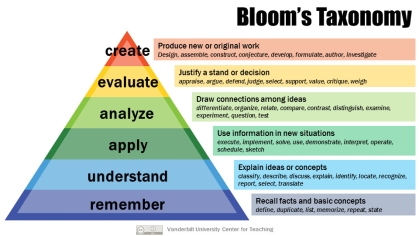Bloom's Taxonomy: How to Ask Questions During Lectures
Do you ever feel stuck on how to ask questions during lectures? Have you felt nervous about how to create a question because you are very confused?
Being confused is an opportunity to ask questions so your instructors can support your understanding. Here, I will outline Bloom’s Taxonomy1 and how to use it to formulate questions.

Introduction
Usually, confusion is associated with a lack of clear understanding. According to Bloom’s Taxonomy (Armstrong, 2010), understanding and remembering content is the foundation to our knowledge. We need to strengthen those levels of thinking in order to reach higher levels of thinking found in our assessments. During lectures, it is important to tackle those levels of thinking while the instructor is accessible because our assignments tend to fall under higher levels of thinking.
Below are some sentence stems to help create questions:
Remember
- How many...?
- What is...?
- Where can I find...?
Understand
- What happened after...?
- What is the difference between...?
- How would you describe...?
Example
Let’s say I was attending my "Abnormal Psychology" course, and it was about two weeks before our midterm exam. My instructor is introducing a new disorder, bipolar disorder, that will be on the midterm exam, though I am struggling to understand how it is different from last week’s disorder, depressive disorders. These disorders are very similar, and I noticed I am mixing up the information during studying.
Since I noticed my confusion during studying, I can prepare a few questions to ask during class time.
- To strengthen my basic understanding, I can ask, “What is the difference between bipolar and depressive disorders?”
- To analyze the differences, I can ask, “What research proves that bipolar disorders are separate from depressive disorders?”
Conclusion
It may help to have a few go-to sentence stems to help formulate questions, so you are not struggling to ask questions during lecture.
- If you are thinking about questions while studying, write them down and ask a few during class.
- If you have questions during lecture while your instructor is speaking, you could refer to the Bloom’s Question Suggestions PDF handout to support your thinking. Writing down the question prior to raising your hand could increase your confidence.
The next time you feel confused about content, use these strategies to build your confidence in asking specific questions. Your instructors are there to help clarify your comprehension.


